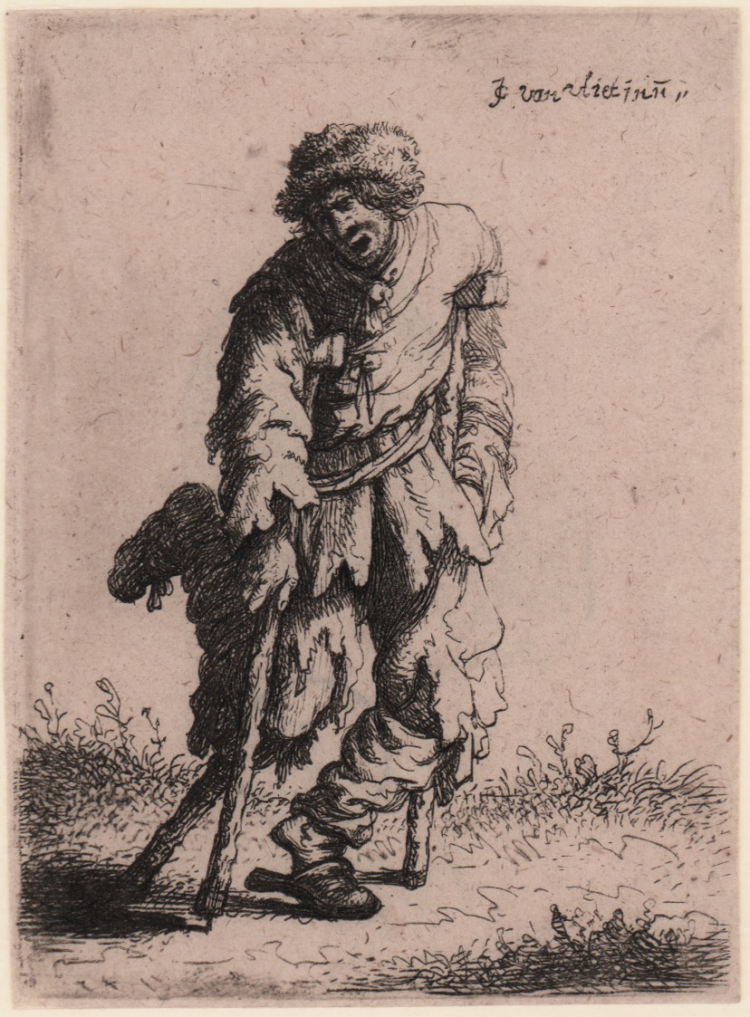




| Reference: | S13064 |
| Author | Jan van VLIET |
| Year: | 1632 |
| Measures: | 65 x 89 mm |



| Reference: | S13064 |
| Author | Jan van VLIET |
| Year: | 1632 |
| Measures: | 65 x 89 mm |
A beggar with a wooden leg; walking to right on two crutches.
Etching and engraving, 1632, lettered on the sheet: “JG van vliet inv.".
From a series of ten plates (Hollstein 73-82), after Rembrandt.
Magnificent impression, rich in shades, printed on contemporary laid paper without watermark, trimmed to platemark or with thin margins, in excellent condition.
Jan van Vliet, Dutch draughtsman and etcher, owes his reputation to the fact that from c. 1629 he worked for Rembrandt in Leiden for a few years and again after Rembrandt moved to Amsterdam in 1631. However, it is uncertain whether van Vliet also moved to Amsterdam. He was not Rembrandt’s pupil but an independent etcher, who also made etchings after his own designs. He collaborated with Rembrandt in preparing his painted compositions as prints and also copied etchings by Rembrandt. Van Vliet’s etchings after his own designs were done during the same period he was working for Rembrandt, and these works he signed. Some are thematically derived from Rembrandt, such as this series of Beggars (1632), a subject etched by Rembrandt c. 1630. Van Vliet’s principal subjects were drawn from everyday life and depicted peasants, card-players, craftspeople and brothel scenes. However, his work lacks the humorous force of comparable works by such artists as Adriaen van Ostade, Jan Miense Molenaer and Cornelis Dusart.
Ex collezione: Nagler (Lugt 2529); Baron von Derschau (Lugt 2510); Gabinetto delle Stampe di Berlino (Lugt 1606)
Bibliografia
'Rembrandt and van Vliet. A collaboration on Copper', exh. cat. (Amsterdam: Rembrandthuis), Amsterdam 1996, cat.56; Hollstein / Dutch and Flemish etchings, engravings and woodcuts c.1450-1700 (74); Bartsch-Claussin 1797-1828 / Catalogue raisonné de toutes les estampes de Rembrandt (plus Supplement) (II.102.74).
Jan van VLIET (Delft 1610 - Leida dopo il 1635)
|
Dutch draughtsman and etcher. He owes his reputation to the fact that from c. 1629 he worked for Rembrandt in Leiden for a few years and again after Rembrandt moved to Amsterdam in 1631. However, it is uncertain whether van Vliet also moved to Amsterdam. He was not Rembrandt’s pupil but an independent etcher, who also made etchings after his own designs. He collaborated with Rembrandt in preparing his painted compositions as prints and also copied etchings by Rembrandt. In addition, van Vliet made etchings after works by other artists, for example Susanna and the Elders after a painting by Jan Lievens (untraced). Van Vliet’s etchings after his own designs were done during the same period he was working for Rembrandt, and these works he signed. Some are thematically derived from Rembrandt, such as the series of Beggars (1632), a subject etched by Rembrandt c. 1630. Van Vliet’s principal subjects were drawn from everyday life and depicted peasants, card-players, craftspeople and brothel scenes. However, his work lacks the humorous force of comparable works by such artists as Adriaen van Ostade, Jan Miense Molenaer and Cornelis Dusart. While van Vliet’s early work is dependent on Rembrandt’s style, the later etchings are divided between a much rougher manner and a strongly simplified technique, for example the series of Tradesmen (1635). Van Vliet’s career seems to have been a short one, as his last dated work is from 1635. A number of drawings and paintings have been attributed to him, but these are doubtful.
|
Jan van VLIET (Delft 1610 - Leida dopo il 1635)
|
Dutch draughtsman and etcher. He owes his reputation to the fact that from c. 1629 he worked for Rembrandt in Leiden for a few years and again after Rembrandt moved to Amsterdam in 1631. However, it is uncertain whether van Vliet also moved to Amsterdam. He was not Rembrandt’s pupil but an independent etcher, who also made etchings after his own designs. He collaborated with Rembrandt in preparing his painted compositions as prints and also copied etchings by Rembrandt. In addition, van Vliet made etchings after works by other artists, for example Susanna and the Elders after a painting by Jan Lievens (untraced). Van Vliet’s etchings after his own designs were done during the same period he was working for Rembrandt, and these works he signed. Some are thematically derived from Rembrandt, such as the series of Beggars (1632), a subject etched by Rembrandt c. 1630. Van Vliet’s principal subjects were drawn from everyday life and depicted peasants, card-players, craftspeople and brothel scenes. However, his work lacks the humorous force of comparable works by such artists as Adriaen van Ostade, Jan Miense Molenaer and Cornelis Dusart. While van Vliet’s early work is dependent on Rembrandt’s style, the later etchings are divided between a much rougher manner and a strongly simplified technique, for example the series of Tradesmen (1635). Van Vliet’s career seems to have been a short one, as his last dated work is from 1635. A number of drawings and paintings have been attributed to him, but these are doubtful.
|